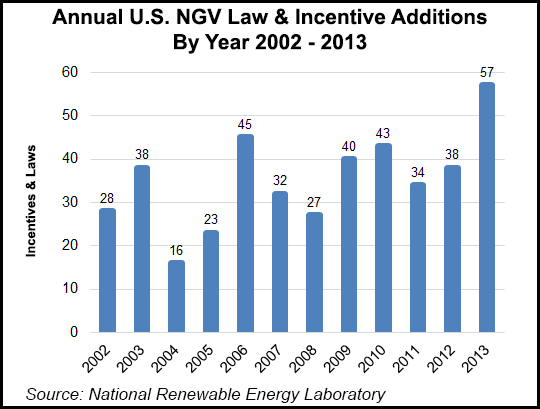Infrastructure | NGI All News Access | NGI The Weekly Gas Market Report
Texas Finds Gusher in NGV Fueling; Industry Applauds
For the fiscal year ended July 31, Texas tax revenues from the sale of natural gas for transportation were more than double the expected total, reaching $2.17 million, according to the state comptroller. People connected with initiatives for getting more natural gas vehicles (NGV) on the road in Texas and elsewhere welcomed the news.

Leading the applause was Texas Railroad Commissioner David Porter, who said the comptroller’s report shows that sales of compressed natural gas (CNG) and liquefied natural gas (LNG) for transportation equaled 14.5 million gasoline gallon equivalents (GGE) over the 12 months ending July 31.
“These collections are more than double the estimated amount,” said Porter, adding that the state initially expected to collect $992,000 in NGV-related tax revenues from a projected 6.6 million GGE. “NGVs are becoming mainstream faster than expected.”
In California, Newport Beach-based Clean Energy Fuels Corp.’s Peter Grace, senior vice president for sales and finance, said it was obvious that the use of natural gas for transportation is “taking off” in Texas. “We firmly agree with Porter that there is plenty of room for growth as more fleets take advantage of the economic and environmental benefits of NGVs.”
Grace said Clean Energy operates about 40 public-access fueling stations in Texas.
“The latest excellent sales figures represent only a fraction of potential sales as more and more fleet operators take advantage of the cost-saving, lower-emissions and energy-security benefits of Texas natural gas,” Porter said.
Porter is helping host a “Texas Natural Gas Summit” on Oct. 23 in Austin.
Meanwhile, the latest technology breakthroughs for NGVs include a new methane-detection device from North Carolina-based USA Pro Shoreline Technology. Using sensors, cables and displays from Alabama fire safety equipment specialist Amerex, USA Pro has introduced AMGaDS IV, its latest detection system for NGV operations.
Safety for the still-young NGV industry shouldn’t be taken for granted, said USA Pro’s Dustin Brewer. Requirements vary on onboard vehicle gas-detection systems, he said. As an example, the methane detector is required for LNG use, but not CNG use in vehicles.
Brewer told the industry newsletter Fleets & Fuels that he has “growing concerns” about gas detection being considered for removal as it apparently is in the refuse hauling sector. “Vehicles receive repeated shock and vibration from roads,” Brewer said. “[This] increases the likelihood that leaks will occur, and a leak could happen anywhere.”
Among the industry vehicle and engine makers, Westport has gained U.S. Environmental Protection Agency certification for its 2015 Ford E-450, F-450, F-550, F-650, and F-59 vehicles. They are vehicles converted to dedicated CNG operation, using the Westport WiNG fuel system.
California Air Resources Board certification for the dedicated 2015 Ford NGVs is expected soon.
Separately, truck maker Kenworth said it has added the dedicated NGV Cummins Westport ISX12 G engine as an option on both its day cab and 52-inch mid-roof sleep versions of its new T880 that began production late last year. The ISX12 G can run other either CNG or LNG.
In the fueling space, TruStar Energy said it has entered a contract to upgrade its CNG fueling station in Bakersfield, CA, in the center of California’s oil/gas industry. TruStar has indicated it will remove old compressors and associated infrastructure at the public access facility, replacing it with “state-of-art” compressors, fueling hoses, dispensers and a canopy.
Since the station opened nearly a decade ago, it has gone from fueling 10 to 60 school buses daily. “We have just outgrown the station in all shapes and forms,” said the local school superintendent.
© 2024 Natural Gas Intelligence. All rights reserved.
ISSN © 1532-1231 | ISSN © 2577-9877 | ISSN © 1532-1266 |
